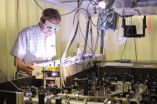(Press-News.org) Stanford Woods Institute for the Environment researchers have helped open a new door of possibility in the high-stakes effort to save the world's coral reefs.
Working with an international team, the scientists – including Stanford Woods Institute Senior Fellows Jeff Koseff, Rob Dunbar and Steve Monismith – found a way to create future ocean conditions in a small lab-in-a-box in Australia's Great Barrier Reef. The water inside the device can mimic the composition of the future ocean as climate change continues to alter Earth.
Inside the mini-lab, set in shallow water 2 to 6 feet deep, elevated levels of water acidity were created to test the reaction of a few local corals. (Other corals in the vicinity were not adversely affected.)
It was the first controlled ocean acidification experiment in shallow coastal waters. The scientists' study, published in Scientific Reports, describes how they simulated predicted future ocean conditions off Heron Island in Australia's Great Barrier Reef, representing a new paradigm for analyzing how reefs respond to ocean acidification. David Kline and Ove Hoegh-Guldberg at the University of Queensland led the project.
Focusing conservation efforts
"Installing systems like this at reefs and other aquatic environments could be instrumental in helping us identify how ecosystems will change and which locations and ecosystem types are more likely to remain robust and resilient," said Lida Teneva, a Stanford doctoral student studying with Dunbar.
"From this, we can determine which habitats to focus our conservation efforts on as strongholds for the future," Teneva said.
Oceans absorb more than a quarter of all atmospheric carbon dioxide, concentrations of which are increasing at a rate twice as fast as at any time in the past 800,000 years or more. This leads to increasingly intense water acidification and widespread coral reef destruction. The potential loss is tremendous: reefs provide aquaculture, protein and storm protection for about 1 billion people worldwide.
Standard in situ studies of ocean acidification have multiple drawbacks, including a lack of control over treatment conditions and a tendency to expose organisms to more extreme and variable pH levels than those predicted in the next century. So, in 2007, the Monterey Bay Aquarium Research Institute developed a system that allows for highly controlled semi-enclosed experiments in the deep sea. For their recent study, Stanford researchers modified the system for use in coral reefs.
The complex device, the Coral Proto – Free Ocean Carbon Enrichment (CP-FOCE) system, uses a network of sensors to monitor water conditions and maintain experimental pH levels as offsets from environmental pH. It avoids many of the problems associated with standard in situ ocean acidification studies, and – unlike lab and aquarium experiments – makes it possible to study amid natural conditions such as seasonal environmental changes and ambient seawater chemistry.
###
COMMENT:
Rob Jordan, Stanford Woods Institute for the Environment: (650) 721-1881, cell (415) 760-8058, rjordan@stanford.edu
Stanford researchers help predict the oceans of the future with a mini-lab
2012-06-08
ELSE PRESS RELEASES FROM THIS DATE:
Mystery to the origin of long-lived, skin-deep immune cells uncovered
2012-06-08
Scientists at A*STAR's Singapore Immunology Network (SIgN) uncovered the origin of a group of skin-deep immune cells that act as the first line of defence against harmful germs and skin infections. SIgN scientists discovered that these sentry cells of the skin, called the Langerhans cells (LCs), originate from two distinct embryonic sites - the early yolk sac and the foetal liver.
LCs are dendritic cells (DCs) found in the outermost layer of the skin. DCs are a critical component of the immune system because they are the only cells able to 'see' and 'alert' other responding ...
Virgin male moths think they're hot when they're not
2012-06-08
SALT LAKE CITY, June 6, 2012 – Talk about throwing yourself into a relationship too soon.
A University of Utah study found that when a virgin male moth gets a whiff of female sex attractant, he's quicker to start shivering to warm up his flight muscles, and then takes off prematurely when he's still too cool for powerful flight. So his headlong rush to reach the female first may cost him the race.
The study illustrates the tradeoff between being quick to start flying after a female versus adequately warming up the flight muscles before starting the chase. Until the ...
Vampire jumping spiders identify victims by their antennae
2012-06-08
Evarcha culicivora jumping spiders, also known as vampire spiders, are picky eaters by any standards. Explaining that the arachnid's environment is swamped with insects, Ximena Nelson from the University of Canterbury, New Zealand, says, 'You can see from the diet when you find them in the field that there is a high number of mosquitoes in what they eat'. And when Robert Jackson investigated their diet further, he found that the spiders were even more selective. The delicacy that E. culicivora prize above all others is female blood-fed Anopheles mosquitoes, which puzzled ...
Pre-existing mutations can lead to drug resistance in HIV virus
2012-06-08
In a critical step that may lead to more effective HIV treatments, Harvard scientists have found pre-existing mutations in a small number of HIV patients. These mutations can cause the virus to develop resistance to the drugs used to slow its progression.
The finding is particularly important because, while researchers have long known HIV can develop resistance to some drugs, it was not understood whether the virus relied on pre-existing mutations to develop resistance, or if it waits for those mutations to occur. By shedding new light on how resistance evolves, the study, ...
Study sheds new light on role of genetic mutations in colon cancer development
2012-06-08
SEATTLE – In exploring the genetics of mitochondria – the powerhouse of the cell – researchers at Fred Hutchinson Cancer Research Center have stumbled upon a finding that challenges previously held beliefs about the role of mutations in cancer development.
For the first time, researchers have found that the number of new mutations are significantly lower in cancers than in normal cells.
"This is completely opposite of what we see in nuclear DNA, which has an increased overall mutation burden in cancer," said cancer geneticist Jason Bielas, Ph.D., whose findings are published ...
Gladstone scientists reprogram skin cells into brain cells
2012-06-08
SAN FRANCISCO, CA—June 7, 2012—Scientists at the Gladstone Institutes have for the first time transformed skin cells—with a single genetic factor—into cells that develop on their own into an interconnected, functional network of brain cells. The research offers new hope in the fight against many neurological conditions because scientists expect that such a transformation—or reprogramming—of cells may lead to better models for testing drugs for devastating neurodegenerative conditions such as Alzheimer's disease.
This research comes at a time of renewed focus on Alzheimer's ...
All the colors of a high-energy rainbow, in a tightly focused beam
2012-06-08
For the first time, researchers have produced a coherent, laser-like, directed beam of light that simultaneously streams ultraviolet light, X-rays, and all wavelengths in between.
One of the few light sources to successfully produce a coherent beam that includes X-rays, this new technology is the first to do so using a setup that fits on a laboratory table.
An international team of researchers, led by engineers from the NSF Engineering Research Center (ERC) for EUV Science and Technology, reports their findings in the June 8, 2012, issue of Science.
By focusing intense ...
Bright X-ray flashes created in laser lab
2012-06-08
A breakthrough in laser science was achieved in Vienna: In the labs of the Photonics Institute at the Vienna University of Technology, a new method of producing bright laser pulses at x-ray energies was developed. The radiation covers a broad energy spectrum and can therefore be used for a wide range of applications, from materials science to medicine. Up until now, similar kinds of radiation could only be produced in particle accelerators (synchrotrons), but now a laser laboratory can also achieve this. The new laser technology was presented in the current issue of the ...
Newly identified protein function protects cells during injury
2012-06-08
CINCINNATI – Scientists have discovered a new function for a protein that protects cells during injury and could eventually translate into treatment for conditions ranging from cardiovascular disease to Alzheimer's.
Researchers report online June 7 in the journal Cell that a type of protein called thrombospondin activates a protective pathway that prevents heart cell damage in mice undergoing simulated extreme hypertension, cardiac pressure overload and heart attack.
"Our results suggest that medically this protein could be targeted as a way to help people with many ...
Report addresses challenges in implementing new diagnostic tests where they are needed most
2012-06-08
Easy-to-use, inexpensive tests to diagnose infectious diseases are urgently needed in resource-limited countries. A new report based on an American Academy of Microbiology colloquium, "Bringing the Lab to the Patient: Developing Point-of-Care Diagnostics for Resource Limited Settings," describes the challenges inherent in bringing new medical devices and technologies to the areas of the world where they are needed most. Point-of-care diagnostics (POCTs) bypass the need for sophisticated laboratory systems by leveraging new technologies to diagnose infectious diseases and ...



